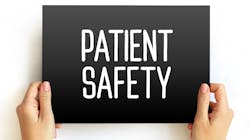Study confirms steady improvement of healthcare safety pre-COVID
A study published in JAMA: The Journal of the American Medical Association and funded and carried out by Health and Human Services (HHS) Agency for Healthcare Research and Quality (AHRQ) shows that rates of in-hospital adverse events for healthcare related patient harm fell significantly in the U.S. in the decade prior to the onset of the COVID-19 pandemic.
Researchers found significant decreases in in-hospital adverse event rates for heart attack, heart failure, pneumonia, and major surgical procedures. After reviewing records of nearly 245,000 patients in more than 3,100 hospitals between 2010 to 2019, this study shows that pre-COVID hospital care was getting safer.
Researchers of this study tracked a total of 21 adverse events over the study period. Examples of the events included adverse medication events such as those associated with the use of insulin or anticoagulants, infections such as central line-associated bloodstream infections and catheter-associated urinary tract infections, and post-procedure events such as those associated with hip joint or knee joint replacement surgeries or postoperative cardiac events.
“America’s doctors, nurses, and allied health workers dedicate their professional lives to serving patients and keeping them safe,” said AHRQ Director Robert Otto Valdez, Ph.D., M.H.S.A. “These study results indicate that we know how to improve patient safety by working together and that we can sustain those results over time. The pandemic has undoubtedly put those successes at risk, but this study should provide motivation for healthcare officials to rebuild and rededicate ourselves to a patient and provider safety doctrine.”
This analysis is the most comprehensive evaluation to date of adverse events that occurred in hospitalized patients in the United States. Adverse events are often defined as physical or psychological harm caused by a person’s interaction with the healthcare system (rather than the underlying disease) that may result in prolonged hospitalization, pain, discomfort, a disability, or even death. Tracking the rates of adverse events is a common way of measuring changes in patient safety.
In the study, researchers examined the rates of adverse events by looking at the raw (observed) rates of adverse events and looking at rates after adjustment for changes in the patient populations and hospitals included in the study over a 10-year period. In the observed data for 2010 and 2019, adverse event rates fell 36 percent for heart attack patients, 31 percent for heart failure patients, 39 percent for pneumonia patients, 36 percent for major surgery patients, but were unchanged for the group of patients representing all other conditions. After adjustment, the relative risk of experiencing an adverse event diminished for all five patient groups, as follows: 41 percent for heart attack patients, 27 percent for heart failure patients, 36 percent for pneumonia patients, 41 percent for major surgery patients, and 18 percent for patients with all other conditions.
Patient safety has been a major healthcare policy issue since 1999, when the Institute of Medicine (now known as the National Academy of Medicine) published To Err is Human, a report that estimated that up to 98,000 Americans die each year as a direct result of medical errors.
Since then, many healthcare organizations have developed and implemented interventions and programs with the aim of improving patient safety. AHRQ’s patient safety efforts, including its Healthcare-Associated Infections Program and implementation of CUSP methodology, team-training curriculum TeamSTEPPS, CAHPS suite of surveys to assess patients’ experience with care, and Patient Safety Organization Program, have been at the forefront of national patient safety efforts.
Those also include programs from other Federal and private-sector organizations, such as the Centers for Medicare & Medicaid Services (CMS), which managed the Partnership for Patients, and implemented payment programs and publicly reported outcomes all geared towards improving patient safety; the Centers for Disease Control and Prevention’s (CDC) work addressing gaps in the public health system and investments in data systems and sharing, infection control, including Project Firstline, environment and sanitation, and vaccines, therapeutics, and diagnostics; and the Institute for Healthcare Improvement External Link Disclaimer, which led the 5 Million Lives Campaign External Link Disclaimer among many others.
“This study serves as evidence of what many in the field of patient safety have long believed, that when we work together towards a common goal, rely on the evidence, and attend to individual patient needs, we can achieve great results,” said Erin Grace, M.H.A., Acting Director of AHRQ’s Center for Quality Improvement and Patient Safety, and another of the study’s co-authors. “This all-in approach will also be critical to future analyses of the impact the COVID-19 pandemic has had on patient safety.”
